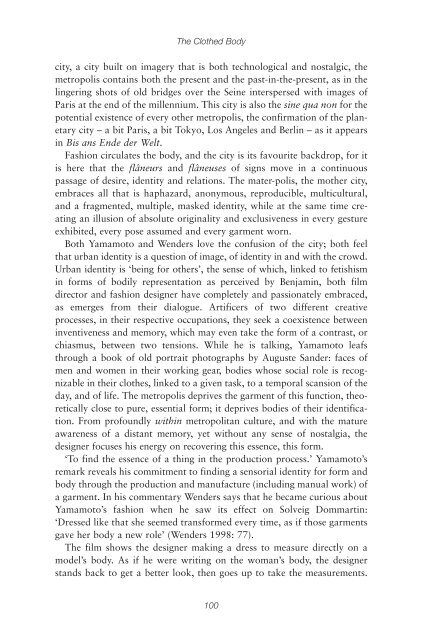Create successful ePaper yourself
Turn your PDF publications into a flip-book with our unique Google optimized e-Paper software.
<strong>The</strong> <strong>Clothed</strong> <strong>Body</strong><br />
city, a city built on imagery that is both technological and nostalgic, the<br />
metropolis contains both the present and the past-in-the-present, as in the<br />
lingering shots of old bridges over the Seine interspersed with images of<br />
Paris at the end of the millennium. This city is also the sine qua non for the<br />
potential existence of every other metropolis, the confirmation of the planetary<br />
city – a bit Paris, a bit Tokyo, Los Angeles and Berlin – as it appears<br />
in Bis ans Ende der Welt.<br />
Fashion circulates the body, and the city is its favourite backdrop, for it<br />
is here that the flâneurs and flâneuses of signs move in a continuous<br />
passage of desire, identity and relations. <strong>The</strong> mater-polis, the mother city,<br />
embraces all that is haphazard, anonymous, reproducible, multicultural,<br />
and a fragmented, multiple, masked identity, while at the same time creating<br />
an illusion of absolute originality and exclusiveness in every gesture<br />
exhibited, every pose assumed and every garment worn.<br />
Both Yamamoto and Wenders love the confusion of the city; both feel<br />
that urban identity is a question of image, of identity in and with the crowd.<br />
Urban identity is ‘being for others’, the sense of which, linked to fetishism<br />
in forms of bodily representation as perceived by Benjamin, both film<br />
director and fashion designer have completely and passionately embraced,<br />
as emerges from their dialogue. Artificers of two different creative<br />
processes, in their respective occupations, they seek a coexistence between<br />
inventiveness and memory, which may even take the form of a contrast, or<br />
chiasmus, between two tensions. While he is talking, Yamamoto leafs<br />
through a book of old portrait photographs by Auguste Sander: faces of<br />
men and women in their working gear, bodies whose social role is recognizable<br />
in their clothes, linked to a given task, to a temporal scansion of the<br />
day, and of life. <strong>The</strong> metropolis deprives the garment of this function, theoretically<br />
close to pure, essential form; it deprives bodies of their identification.<br />
From profoundly within metropolitan culture, and with the mature<br />
awareness of a distant memory, yet without any sense of nostalgia, the<br />
designer focuses his energy on recovering this essence, this form.<br />
‘To find the essence of a thing in the production process.’ Yamamoto’s<br />
remark reveals his commitment to finding a sensorial identity for form and<br />
body through the production and manufacture (including manual work) of<br />
a garment. In his commentary Wenders says that he became curious about<br />
Yamamoto’s fashion when he saw its effect on Solveig Dommartin:<br />
‘Dressed like that she seemed transformed every time, as if those garments<br />
gave her body a new role’ (Wenders 1998: 77).<br />
<strong>The</strong> film shows the designer making a dress to measure directly on a<br />
model’s body. As if he were writing on the woman’s body, the designer<br />
stands back to get a better look, then goes up to take the measurements.<br />
100

















